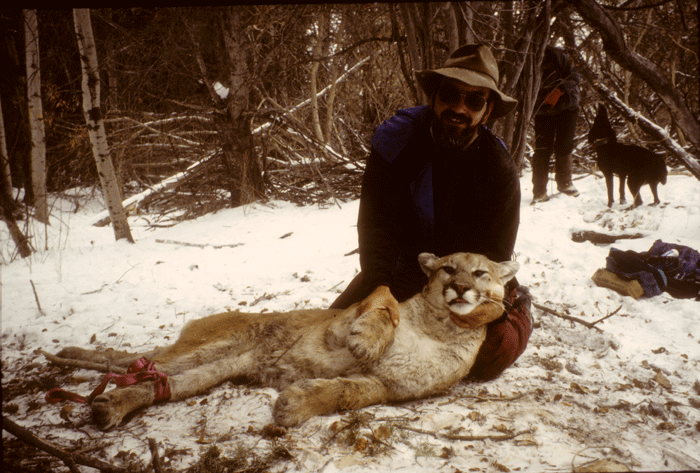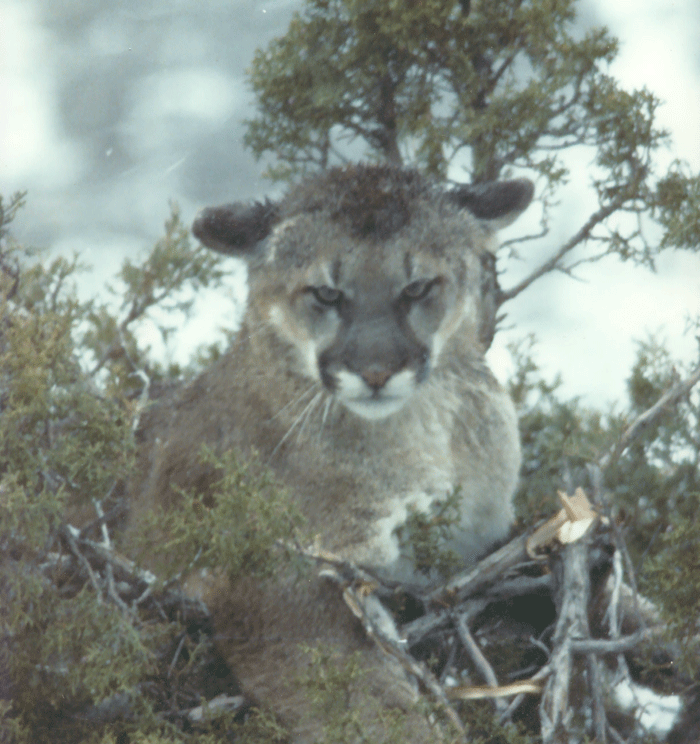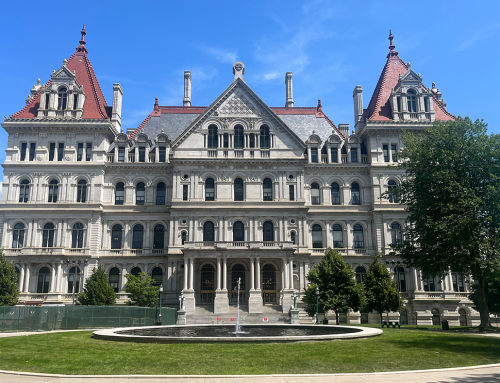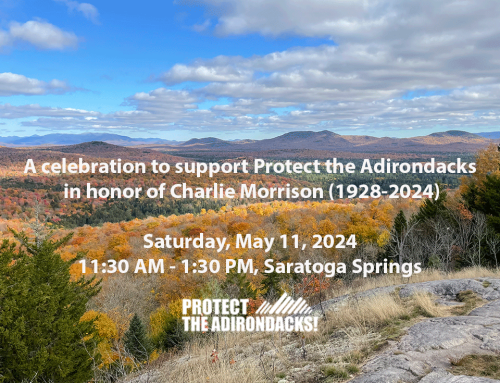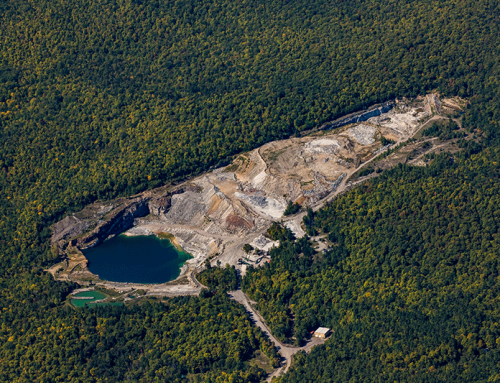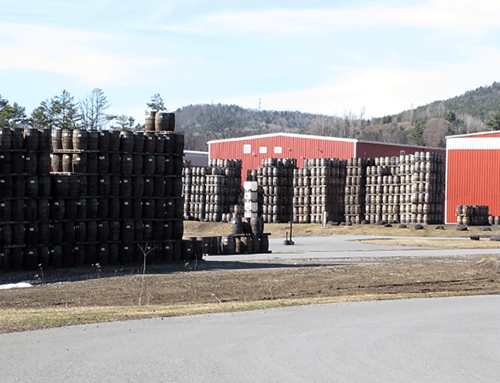Note: Protect the Adirondacks does not have a position on the reintroduction of cougars to the Adirondack Park, but we welcome the work of Dr. John Laundre, a wildlife biologist from the State University of New York at Oswego, for bringing fresh data and analysis to the many questions around this idea.
In 2004, Protect the Adirondacks Board member and naturalist author Peter O’Shea was profiled in The New York Times, and in the Washington Post in 2005, about his stalwart work to record cougar sightings throughout the Adirondacks from the general public. Throughout the past 20 years O’Shea has recorded sightings of cougars (also called mountain lions or pumas;Â Puma con color is the scientific name) from hundreds of people and several times he even tracked cougars in the Adirondacks. Adirondack Explorer editor Phil Brown writes about once seeing a cougar in the Park.
While there have been a number of reports of cougars with kittens during these years, none have been confirmed. Without evidence of a sustained local population, debate about the Park’s viability to support a cougar population has been ongoing. The Fish and Wildlife Service has declared cougars officially extinct in the eastern U.S., though it remains a protected species under the Endangered Species Act. There are no plans for any cougar restorations in the Adirondacks or anywhere else in the eastern U.S. at this time.
Cougars number in the tens of thousands west of the Mississippi River and occupy almost all large mountainous areas in western states. There are an estimated 15,000 cougars in California alone. In recent years, cougars have naturally recolonized several parts of the west including the Black Hills of South Dakota, the Badlands of North Dakota, and the Pine Ridge area of western Nebraska. South Dakota has embarked upon a new hunting season for cougars this year and plans to take 100 or the estimated 150 cougars that now populate the Black Hills.
John Laundre is a wildlife biologist at the State University of New York at Oswego (shown below with a sedated cougar during a field study out west). He has been studying cougars for more than 20 years. He believes that cougars could establish viable populations in a number of locations throughout the eastern U.S. including the Smokey Mountains, parts of West Virginia, Blue Ridge Mountains in Virginia, eastern Kentucky, the Green Mountains in Vermont, White Mountains in New Hampshire, northern Maine, among other areas, and the Adirondack Park.
A cougar population of around 150 has survived in Florida. It was successfully augmented recently with the introduction of several males to help widen the gene pool. This population is a remnant population from a time when cougars thrived coast to coast. The Florida population is considered far beyond the reach of even the most freewheeling and well traveled young male cougars to reach on their own (one cougar was recently documented as having traveled from South Dakota to Connecticut, where it was run over by an SUV).
Laundre has been involved in a number of long-term studies of cougars out west. He is also active with the Cougar Rewilding Foundation, which is focused on making opportunities for cougars to establish viable populations via reintroductions throughout the eastern U.S. Laundre brought his experiences to research on the question of the viability of the Adirondack Park to support a cougar population. He believes that the answer is “yes” and that the Adirondack Park offers what is perhaps the best opportunity east of the Mississippi River for the establishment of a small, yet sustained cougar population.
Laundre recently published this thesis in the journal Oryx (The International Journal of Conservation) entitled The Feasibility of the Northeastern USA Supporting the Return of the Cougar. Laundre’s argument is that the Adirondack landscape has enough deer and enough wild areas to support upwards of 150-350 cougars, similar to the recolonized populations in the Dakotas and Nebraska. As long as there is prey and wild habitat, cougars can survive. Laundre believes that the scientific findings over the past three decades show that cougars are highly adaptable and can flourish in close proximity to human populations.
To make this argument Laundre looked at four things: 1) review of the scientific literature about cougars over the past 30 years to address the conclusions reached in the 1980s by scientists in New York that the Adirondack Park was not wild enough to support a viable cougar population that has held sway ever since; 2) an assessment of the habitat and landscape features of the Adirondacks; 3) prey base for cougars in the Adirondacks; and, 4) he compared the Park with other areas where cougar populations have successfully established.
What have we learned in the last 30 years about cougars? New York scientists studied the question of a cougar population and cougar reintroduction in the Adirondack Park in the 1980s. They concluded that the Park could not support a viable cougar population due to a high road density and needs of cougars for vast wild unbroken habitat. Laundre writes “A main assumption of the earlier analysis was that cougars needed wilderness or wild areas with low human and road densities to survive.”
Laundre consulted the scientific literature and found that cougars live in areas in other parts of the U.S. even more populated than the Adirondacks. The Adirondack Park has a population of about 5.3 people per square kilometer and a building density of 2.1 buildings per square kilometer. (A square kilometer is roughly 247 square acres.) Cougars out west live in locations with far greater human and building population densities.
“Thirty years ago everyone thought cougars needed to live in the most remote places, but they’ve demonstrated that they are as adaptable as coyotes.” Laundre points to a longstanding viable cougar population in the Santa Monica Mountains, outside of Los Angeles. “There’s even a young, radio-collared male wandering around LA’s Griffith Park. That’s like taking up residence in Van Cortland Park in the Bronx,” he said.
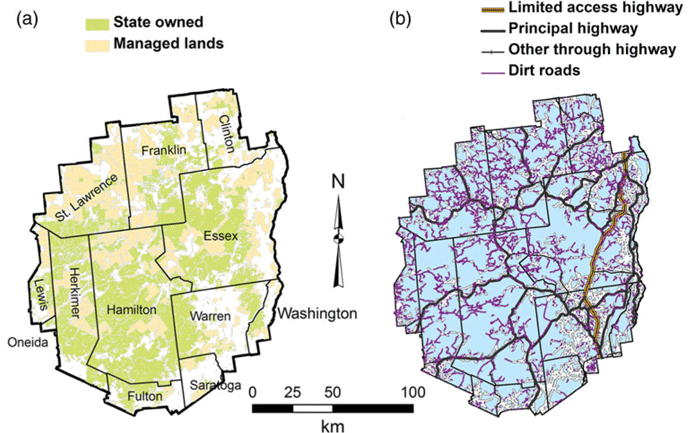
(a) Outline of Adirondack State Park, indicating the extent of state-owned land and resource management lands; county boundaries are also indicated. (b) Distribution of the various types of roads in the Park; the main roads are paved and carry most of the Park's traffic. Source: Oryx, 47(1), 96–104
Habitat assessment. A major issue for cougar restoration to the Adirondacks is road density. 30 years ago the Park’s road density was seen as too great, but Laundre does not believe this is a deterrent. “The Black Hills (South Dakota) has a healthy cougar population, even with a higher road density than the Adirondacks. The paved road network in the Adirondacks is similar to that of Yellowstone and there’s a healthy cougar population in Yellowstone” said Laundre. He’s careful to separate dirt roads and paved roads because they impact wildlife in different ways. “Paved roads are usually much wider and cars drive faster. Dirt roads are smaller and people don’t drive nearly as fast on them. As a result road kill is far less on dirt roads.” Laundre believes that the impact of dirt roads should be minimized. The maps above show extensive large forested areas in the Adirondacks with minimal roads (low traffic roads) that Laundre created as part of his analysis. Laundre believes that road density in the Adirondack Park is not a practical obstacle for cougars establishing a viable population in the Adirondacks. He classifies 88% of the Park’s roads as “low traffic.”
Does the Adirondack Park have the prey base to support a viable cougar population? Cougars eat mostly deer. They will diversify and eat coyotes, beavers, porcupines, bobcats, and other small mammals, but it is estimated that an adult cougar will kill 30-40 deer each year. Hence a population of 300 cougars would take between 9,000-12,000 deer (both adults and fawns). The Adirondacks have a deer population estimated variously by scientists of somewhere between 3.3-6.8 deer per square kilometer (247 acres). Certainly the population shifts with habitat and terrain across the Park. Total Adirondack deer population estimates run by various scientists range from 56,000 deer to upwards of 95,000, with fawns ranging from 39,000-66,000 annually. Annual fawn mortality is high.
It’s important to note, argues Laundre, that cougars are hunters. They take a wide variety of deer, from fawns to adults in their prime. Whereas wolves, and even coyotes in smaller numbers, will select weak and vulnerable deer and then run them down, a cougar stealthily surprises its victims. There is evidence that coyotes have formed rudimentary packs that hunt collectively and chase down deer, especially in the winter where deer are run down on frozen lakes and ponds.
“Wolves hunt the weakest, will test a herd, figure out the easiest and then run them down. Cougars will sneak up and lay in wait. The data did not show a strong selection pressure on particular group. Cougars do not form packs, but they form family groups where the sisters and daughters will show a low level of cooperation,” said Laundre. Cougars will also kill and eat coyotes.
The level of prey that exists does not seem to be an issue based on Laundre’s analysis. The political or social issue of whether hunters in the Adirondacks want to share deer with cougars is another question entirely.
How does the Adirondack Park compare with other areas that have established cougar populations? Laundre references the Black Hills of South Dakota, an area with similar human and deer population densities as the Adirondacks, but more roads. There a cougar population of 120-150 cats has recolonized the area. He says the population would likely continue to expand, but South Dakota recently passed a new cougar hunting law with the aim of decimating the population.
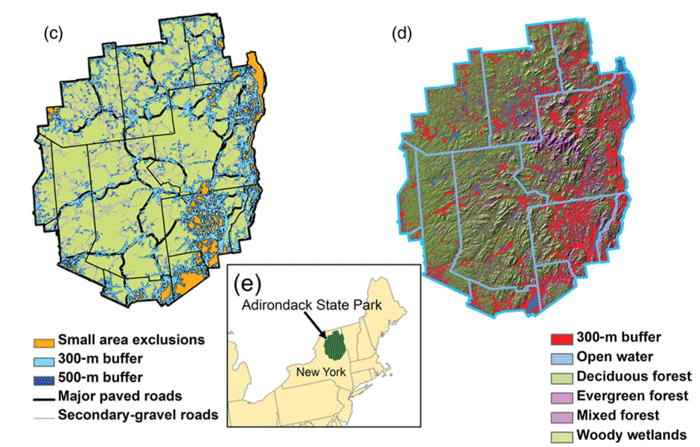
(c) Distribution of lands excluded from possible cougar use assuming 300- and 500-m buffers around buildings in the Park. (d) Vegetation composition of the land available for use by cougars; the 300-m buffer is included as a reference to where towns and buildings are located. (e) Location of Adirondack State Park in the state of New York in the north-eastern United States. Source: Oryx, 47(1), 96–104
In the Adirondacks, Laundre analyzed the built environment and mapped impact zones from houses and roads (see map above). He digitized all buildings and paved roads at 300 meter and 500 meter “impact zones.” Buildings are located at the center of either a 300-meter or 500-meter diameter. He determined that the Park’s built environment was not suitable cougar habitat. When he analyzed the land base in the Park outside the 300-meter and 500-meter impact zones of the total built environment he found large wild open spaces. Laundre calculated over 4.3 million acres in the Park outside 500-meter impact zones that he believes is viable cougar habitat (see maps above). The area in the Park outside the 300-meter impact zones is over 5 million acres.
Laundre believes that his Park-wide analysis answers the question of whether or not the Adirondacks is suitable habitat to support a viable cougar population. He concludes that the data shows viable habitat in the Adirondacks that could support upwards of 350 cougars.
The answer to the cougar question has largely rested on analysis by scientists in the 1980s who concluded that the Park’s built environment was too great to support a cougar population because they needed large wild geographic areas to roam and hunt. They also concluded that deer population densities were not sufficient. Laundre’s analysis is based about new analytic tools not available in the 1980s. This new analysis challenges what he considers dated conclusions and assumptions.
Laundre’s proposal was written about in the Adirondack Almanack, Times Union, and the Syracuse Post Standard. A common refrain among other scientists is that any cougar reintroduction to the Adirondacks would see a dispersal of cougars far and wide, something that happened with a number of reintroduced lynx in the late 1980s that left the Park upon reintroduction. Laundre believes that the Park’s deer habitat and safety of its wild landscape would hold a reintroduced population. If cougars did roam outside the Park, it’s important to note that based on ample sightings over the years that cougars have been moving through and around the Park for decades and this has not been an issue.
In Florida, cougars were formally reintroduced to augment the small local population. Studies of these cats found that they mostly stayed put in their new habitat.
At one time the cougar population in the Adirondacks was robust. The 2011 5-Year Review of cougars in the east by the U.S. Fish and Wildlife Services writes “Bounties of $20 were initiated in 1871, and from 1871 to 1882 a total of 46 were killed for bounty payments (Young and Goldman 1946). Seton (1929) reported that pumas were ‘practically exterminated’ and ‘odd ones were still reported’ in the Adirondack Mountains – the last stronghold for the puma. He said that J. R. Simms recorded that Thomas Meacham, a trapper who died about 1849 killed 77 pumas in the Adirondacks. C. Hart Merriam (1882) reported that E. L. Shepherd had killed 28 pumas by 1883. Seton believed the last puma was killed in New York in 1890, and documents a bounty paid in 1889 from the Adirondacks and a mounted specimen killed in 1897. A total of 107 were bountied from 1879 to 1890 (Nowak 1976). The last bounty was paid in 1894 for an animal taken in Herkimer County (Reilly 1964). Manville (1951) claims a bounty was paid in 1897, but the documentation is uncertain (Reilly 1964). Goodwin (1936) also concurred that the last record was in 1894. Miller (1899) stated that the puma had been eliminated in all but the wilder portions of the Adirondacks. A State Game Commission report published about 1904 said the puma was extirpated (Reilly 1964). A puma was reportedly killed near Elk Lake in 1908 (Young and Goldman 1948). Various unsubstantiated reports were discussed by Manville (1951), Seagears (1956), Reilly (1964), and Wright (1972).”
The question of natural recolonization of cougars in the Adirondacks? Recent decades have seen cougars establish viable new populations in several areas in the west. Female cougars have home ranges and sister and daughter cats will live in fairly close proximity to one another. Often several or more female home ranges are found within the home range of one male. Sub-adult males are driven off by the dominant male.
Laundre’s research about cougars out west has shown him that cougars will take up residence in areas where there is adequate prey. Movement of males is widespread as young adults have to find new areas or roam until they reach maturity and can challenge dominant males. Cougars that have made forays into the east are largely independent roaming males. Female cougars do not range as far. While there have been ample cougar sitings in the Adirondacks, there has never been confirmation of a local breeding population. Given the vast distance of the Adirondacks from cougar populations in Florida or North and South Dakota, the closest confirmed breeding populations, Laundre does not belives that natural recolonization is a viable strategy for establishing a cougar population in the Adirondacks.
The Adirondacks have seen natural recolonization by moose and wild turkeys. Bald eagles were successfully re-established, whereas the lynx restoration in the late 1980s was deemed a failure. Many argue that simply too few lynx were released. Laundre points out that lynx are specialists for their diet preying mostly on snowshoe hare, where cougars are generalists and will eat a variety of different species, which has aided cougars’ adaptability in other areas.
Laundre recommends what he terms a “soft release” of cougars in a theoretical reintroduction to the Adirondacks. He advocates for a program where pregnant females are released after they have been acclimated the Park. This follows the methods used in the successful reintroduction of wolves to Yellowstone, where intact packs and pregnant females were release after periods where they were held in large fenced areas in Yellowstone. In this way family groups could be established where females live with their young in proximity to one another, with males ranging further, but dominant cats remaining near females.
Laundre believes that western cougars are perfectly appropriate for reintroduction in the east. Historically cougars roamed from coast to the coast and the gene pool is well mixed.
Reintroduction would be scoped out as part of the National Fish and Wildlife Service assessments working closely with the the NYS Department of Environmental Conservation. It would be a long process of evaluations and impact studies. Ecologic, social, economic factors, among others, would all be weighed. As Laundre points out, the major stumbling blocks are found in the are social and political questions. He believes his work has answered the biological questions.
One measure of a great park is the wildlife that live there. The Adirondack Park has long been billed as a great safety deposit box for biodiversity, a place where vast numbers of plants and trees in forests, wetlands and mountaintops can flourish unimpeded by humans. But the wildlife of the Adirondack Park has some notable absences. The cougar is a big one. It’s return would say a lot about the wildness of the Adirondacks.
PROTECT salutes Dr. Laundre for bringing sound analysis and good data to the question of cougar reintroduction to the Adirondacks. He work challenges many long-held conclusions and assumptions and has reopened the important question about the return of a long-lost native to the Adirondack Park.

